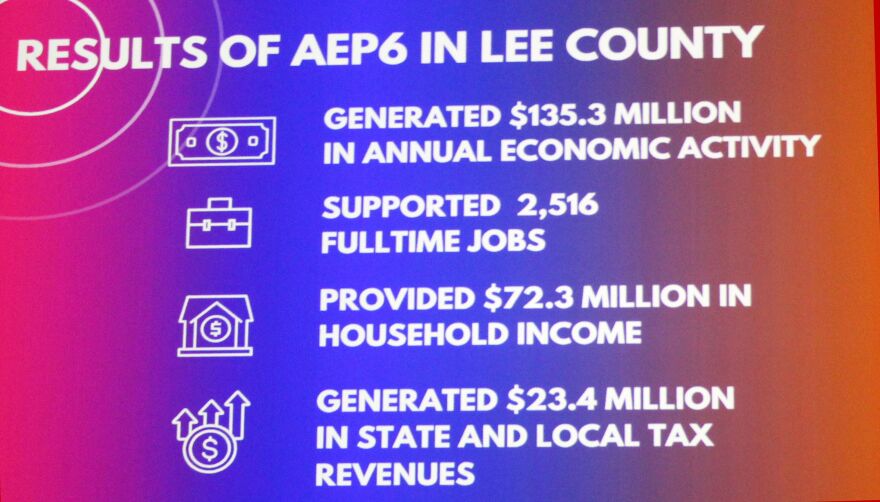Every five years the Americans for the Arts takes the pulse of the arts and culture sector of the national and local economies.
Although many Lee County arts organizations were unable to participate in the Arts & Economic Prosperity 6 study because of staffing and funding limitations attributable to the pandemic and Hurricane Ian, the 19 that did generated $135.3 million in economic impact in 2022, proving that the heartbeat of the arts in Lee County is Olympic-level strong.
The Alliance for the Arts spearheaded the survey in Lee County and Fort Myers.
“We currently support 2,516 jobs in Lee County through the arts,” said Alliance Executive Director Molly Deckart. “We provided $72.3 million in household income, resulting in $23.4 million in tax revenue. Pretty impressive.”
Arts & culture organizations provide rewarding employment for more than just arts administrators, curators and artists. They also employ box office staff, ushers, tour guides, custodians, maintenance staff, building contractors, plumbers and electricians, and people in myriad other occupations from accountants and attorneys to publicists and printers.
But the spending doesn’t stop there. Each dollar paid out by arts & culture organizations in compensation and for goods and other services is typically spent by recipients locally between 7 and 12 times before leaking out of the community – although the magnitude of this ripple effect is not quantified by this year’s Arts & Economic Prosperity study.

The survey makes it clear that residents and business owners in Lee County have a vested interest in ensuring the vitality of arts and culture organizations. They don’t just provide food for the soul. They put food on the table for scores of people who live and work in Lee County.
Yet, county government provides no support to the arts and culture sector.
“Currently, there are no sustainable models of funding through the county for arts organizations, and we’re a big part of that economic engine,” Deckart observes.
The City of Fort Myers provides $110,000 in grants each year to arts organizations and individual artists, but this amount is divided up among a couple of dozen recipients. And neither the county nor Fort Myers provided any funds to help arts and culture organizations recover from the diminished audiences arts & culture organizations experienced in the aftermath of the COVID pandemic and the damage they suffered to their facilities during Hurricane Ian.
“We’ve all been very impacted since Hurricane Ian,” said Deckart on this topic. “There’s not a lot of recovery dollars available for the arts, and therefore we’re shouldering all of the issues that we’ve all experienced. You know, most of us have buildings, and those have had significant damage with not a lot of pathways to recovery outside of additional fundraising on our behalf.”
The Arts & Economic Prosperity 6 study underscores the need for a paradigm shift. Moneys provided to arts & culture organizations for operational expenses and programming are not giveaways. They represent investments in our community’s economic well-being.
This is especially true for the owners and employees of business establishments that are located in, around and near arts venues.

In 2022, the folks who attended the exhibitions, plays, shows and other events produced by just the 19 arts and culture organizations who participated in the study spent $73.7 million at local business establishments. This is over and above the price of admission and the cost of any food or beverages they may have purchased on site.
The 1.4 million locals who attended arts and culture events in 2022 spent an average of $34.86 each at area businesses, while the 426,000 out-of-towners spent $57.68 apiece for things like dining, parking or ride share, souvenirs, apres-event drinks or dessert, and child or pet care. Some 45,000 out-of-towners also paid for overnight lodging at a nearby hotel or B&B, spending an average of $197.70 per person.
“It really has a nice ripple effect,” Deckart said. “So if you’re travelling even from Sarasota to here and you decide to spend the night, you are dining, you are lodging, you are participating in our local economy. And so it just may be a gallery opening, but it really has significant financial impact when you take it on its whole.”
Other cities have already realized the impact that art and cultural events can have on their local economies.
Orlando now has a 10-block-wide festival called IMMERSE that brings tens of thousands of visitors to that city each year.
Meanwhile, Cincinnati’s Blink art, light and projection mapping festival attracts more than 2 million attendees over just 4 days, resulting in a direct economic impact of $126 million.

Work is under way to create an Edison Walk of Innovation in the River District and an international arts and culture festival that will do the same for Lee County and the City of Fort Myers. However, both will require funding by both government entities along with financial support from private partners.
For the first time, AEP6 provides the tools to calculate just how much money area businesses are likely to reap from the audiences who attend these and similar initiatives.
WGCU is your trusted source for news and information in Southwest Florida. We are a nonprofit public service, and your support is more critical than ever. Keep public media strong and donate now. Thank you.
MORE INFORMATION
- The Arts & Economic Prosperity 6 study makes it clear that when a county or municipality funds the arts, it is investing in an industry that stimulates the economy, supports local jobs and contributes to building a healthy and vibrant community.
- According to the Alliance for the Arts, the 19 nonprofit organizations that participated in the American for the Arts’ AEP6 countywide survey were (alphabetically): Acoustic Music Society of Southwest Florida, Americana Community Music Association, Barbara B. Mann Performing Arts Hall, Bob Rauschenberg Gallery at FSW, Broadway Palm Dinner Theatre, Florida Arts (Sidney & Berne Davis Art Center), Florida Gulf Coast University Art Gallery, Florida Repertory Theatre, Fort Myers Film Festival, Grand Piano Series, Gulf Coast Leisure, Gulf Coast Symphony Orchestra, Laboratory Theater of Florida, Lee County Alliance for the Arts, Players Circle Theatre, River District Alliance, Southwest Florida Symphony Orchestra, Theatre Conspiracy, and WGCU Public Media.
- There are two local AEP6 studies, one for Lee County and another for the City of Fort Myers. Both are available on the Americans for the Arts website. Rack cards and other summaries may also be obtained from the Lee County Alliance for the Arts.
- The AEP6 study was conducted over roughly a year. It consists of information provided by participating entities about the jobs they maintain, their annual budgets and the amount they spend for payroll, taxes and goods and services. Separate audience-intercept surveys were provided by the participating entities with the help of the Alliance for the Arts to randomly-selected people attending the exhibitions, shows, concerts and other events they produced throughout 2022.
- The $135.3 million in economic impact recorded for Lee County is a real figure. No estimates or extrapolations were made to account for the qualifying nonprofit arts & culture organizations in Lee County that did not participate in the AEP6 survey. Consequently, the $135.3 million in economic activity for 2022 understates the actual amount of economic activity generated by the nonprofit arts & culture sector of Lee County’s local economy.
- Lee County would undoubtedly offer financial incentives and other forms of support to entice a business planning to establish 2,516 jobs paying $72,332,662 in wages, and generating $4,527,308 in local tax revenues to establish or relocate its corporate headquarters in Lee County.
- The County proudly provides considerable financial support to the Boston Red Sox and Minnesota Twins in connection with the training facilities and stadiums they use for Spring Training. At $69 million according to a 2018 study conducted by the Lee County Sports Development agency, the economic impact of Spring Training is less than that generated by just the 19 Lee County arts & culture organizations that participated in AEP6, although an additional $59 million in economic impact was produced by the 50 amateur baseball tournaments that Lee County hosted in 2021.
- Through its Community Redevelopment Agency and other means, the City of Fort Myers offers millions of dollars in tax and other incentives to companies wishing to construct multi-unit residential rental properties and commercial enterprises that do and will not produce the $98.7 million in economic activity generated and the 1,932 jobs supported by our local arts and culture organizations operating in the City of Fort Myers.
- One can only imagine the incentives and level of support the City would justifiably offer to induce a corporation or other business entity to establish or relocate its operations to Fort Myers if it was planning to employ 1,932 residents, contribute $3,362,280 to City and county coffers, and generate $98,716,139 in economic activity within the City of Fort Myers.
- In addition to the $135.3 million in economic impact, Lee County’s arts & culture organizations also produce authentic cultural experiences that are not only magnets for visitors, tourists and new residents, but foster the creative environment necessary to attract and retain the executives and workers employed by other area businesses.
- The events and programming produced by our local nonprofit arts and culture organizations provide vital income for local merchants – “a value-add that few industries can compete with.”
- 83.5 percent or 355,728 out-of-town arts & culture event attendees reported that the primary purpose of their visit to Lee County was “specifically to attend the performance, event, exhibit, venue or facility” where they were surveyed. In fact, 42.0 percent or 178,929 out-of-towners indicated that it was the first time they had ever attended the specific activity or visited the specific venue where they were surveyed, and 70.7 percent or 301,198 nonlocal attendees responded “I would have travelled to a different community to attend a similar arts and cultural activity” had it not been offered in Lee County.
- Had the 19 participating arts and culture organizations not offered the programming attended by local patrons, 57.5 percent or 806,380 stated that they would have travelled outside Lee County to attend a similar arts or cultural activity.
- These cultural tourism findings demonstrate that if a community fails to provide a variety of opportunities to experience the arts and culture, it risks not attracting cultural tourists and their valuable dollars as well as losing the discretionary spending of its own residents who will travel elsewhere in search of the diverse artistic expressions and authentic cultural experiences they seek.
- If visitors have a positive experience, they may see Lee County as a place they’d ultimately like to live and work in.
- Arts & culture is a fundamental component of livable communities – beautifying the city, bringing joy to residents and celebrating diverse cultural expressions and traditions.
- Arts & culture powers the creative communities where people want to live and work, where entrepreneurs and innovation thrive, and where businesses and nighttime economies flourish. Shared cultural experiences strengthen sense of belonging and community pride.
- “When we support the arts, we are investing in both Lee County’s economic and community development,” says Alliance Executive Director Molly Deckart. “Creating livable communities is economic development.”
- Blink Cincinnati is the largest light and projection mapping festival in the nation. In 2022, Blink covered 30 city blocks and featured 100 unique art experiences, including 28 projection mapping installations, 42 light and art installations, 100 musical performances, 300 drones, and a parade with 2,500 participants, with artists and performers receiving grants to participate.
- In 2022, IMMERSE included more than 1,000 artists who filled 10 city blocks in downtown Orlando with live performances, immersive art installation, and global encounters. Orlando funds IMMERSE through bed and occupancy taxes, as well as grants and funding provided by private partners and benefactors.
To read more stories about the arts in Southwest Florida visit Tom Hall's website: SWFL Art in the News







